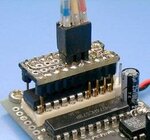KPE
Newbie level 4
I'm looking for some ideas on how to connect two boards in a small and cost effective connection. I will use a programmer board to flash two devices on a small 1x1 inch board, and the small board needs some form of connection for this one time flash procedure. I will have to program 1000+ boards, so I will need something that is hopefully cheap on the small boards. I've been looking into FFC cables/connectors, and also wonder it could be done with test clips or pogo pins. But I don't know what common practices there is, as I'm quite new in the electronics business. These are my first boards ever made, so I'm not sure what my options are.
The space I have left on the board is around 7x14 mm and I will need 10 wires. The bottom plane is occupied by a battery, so there's not room for through hole connectors.
The space I have left on the board is around 7x14 mm and I will need 10 wires. The bottom plane is occupied by a battery, so there's not room for through hole connectors.
